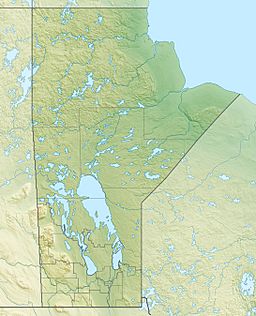Swan Lake (Manitoba) facts for kids
Quick facts for kids Swan Lake |
|
|---|---|
| Location | Division No. 19, Manitoba |
| Coordinates | 52°31′N 100°45′W / 52.517°N 100.750°W |
| Primary inflows | Swan River, Woody River |
| Catchment area | 3,880 sq mi (10,000 km2) |
| Basin countries | Canada |
| Average depth | 7.5 ft (2.3 m) |
| Water volume | 571,200 acre⋅ft (704,600,000 m3) |
| Surface elevation | 851 ft (259 m) |
Swan Lake is a beautiful lake located in the Canadian province of Manitoba. It's a special place, and its name, along with other nearby features, comes from the amazing trumpeter swans that live in this area. These large, white birds are a wonderful sight!
Contents
What is Swan Lake Like?
Swan Lake is quite big, covering an area of about 119 square miles (310 km2). Imagine a lake that's around 308 square kilometers – that's a lot of water! On average, it's about 7.5 feet (2.3 m) deep. This means the lake holds a huge amount of water, about 571,200 acre-foot (705,000,000 m3).
Along the western side of Swan Lake, you'll find a large marsh area. This marsh is near where the Swan River and Woody River flow into the lake. It's a very important spot for many different kinds of birds that stop there during their long migrations.
The Swan Lake Area
The entire area that drains water into Swan Lake is called its drainage basin. This basin is huge, covering about 3,880 square miles (10,000 km2), and it even stretches into the province of Saskatchewan. The lake is nestled between two large forested areas: the Duck Mountains and the Porcupine Hills.
Two main rivers, the Swan River and the Woody River, flow into Swan Lake. The land around the lake also includes Thunder Hill, the Swan River valley, and many smaller streams that feed into the main rivers. The area where the rivers meet the lake forms a delta with lots of wetlands.
Besides Swan Lake, there are about 30 smaller lakes in this basin. Some of the bigger ones include Lac La Course, Madge Lake, Sarah Lake, Wellman Lake, Whitefish Lake, and the Woody Lakes. The land here varies in height, from high points of 2,600 to 2,300 feet in the Porcupine Hills and Duck Mountains, down to 851 feet at Swan Lake itself.
Forests and Farming Around the Lake
The Porcupine Hills and Duck Mountains are covered in forests. A long time ago, most of the Swan Lake basin was also forested. An explorer named Thomas Simpson visited in 1837 and thought the area had great potential for farming. He wrote that people might one day turn this wild land into a place where crops like barley and potatoes could grow.
Today, much of the original forest has been cleared for agriculture. However, the area still has important forestry, hunting, and fishing activities. It's also a popular spot for tourism and outdoor fun. Currently, about 42.7% of the basin is still forested, while 38.4% is used for farming. About 15.5% is covered by water, and the rest is unclassified. Wetlands, like bogs and shallow ponds, make up 10% of the basin, especially in the higher parts of the Duck Mountains and Porcupine Hills, and in the big marsh near Swan Lake.
Weather and Water Use
The Swan Lake basin gets about 19 inches of rain and snow each year. The period without frost, when plants can grow, lasts between 87 and 110 days. On average, about 495,000 acre-foot (610,000,000 m3) of water flows out of the basin each year.
People living in the area can use a certain amount of water for their homes without needing a special permit. In 2005, only a small amount of water, less than 2,000 acre-foot (2,500,000 m3) per year, was approved for other uses with water rights licenses.
Communities Near Swan Lake
Around 14,000 people live in the Swan Lake basin. Many of them live in rural areas outside of the main towns. The only communities directly on the lake are the main reserve of the Wuskwi Sipihk First Nation (Swan Lake 65C) and the northern part of the Rural Municipality of Mountain, both on the western shores.
The largest town in the basin is Swan River, Manitoba, with a population of 4,032 people. Most other communities have fewer than 500 residents.
Here are some of the communities in the Swan Lake basin:
- In Saskatchewan:
- Arran
- Arabella
- Danbury
- Norquay
- Pelly
- Swan Plain
- Whitebeach
- In Manitoba:
- Benito
- Bowsman
- Durban
- Kamsack Beach
- Key Reserve
- Kenville
- Lenswood
- Minitonas
- Novra
- Renwer
- Swan Lake Reserve
Resources


